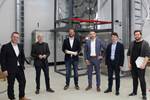Rath to open facility dedicated to continuous oxide ceramic fibers
Initial production of 10 tons of Altra Flex fibers will be produced annually in Germany for a wide range of 3D printing, composite and other application possibilities.
Source | Rath AG
International refractory manufacturer Rath AG (Vienna, Austria) has been developing continuous oxide ceramic fibers as part of InVECOF (Innovative Value Chains for European Ceramic Oxide Fibers) Horizon Europe project for several years. Now, a production facility for the manufacture of innovative oxide ceramic fibers has been commissioned at Rath’s Mönchengladbach site in Germany.
In October 2024, the company launched production of Altra Flex continuous oxide ceramic fibers in K99 AND M75 qualities/grades, enabling Rath to supply solutions to those manufacturing and processing composite materials and temperature-resistant fabrics. The new production plant will initially produce up to 10 tons of fiber per year.
“Drawing on 35 years of experience in the development and production of high-temperature ceramic fiber, Rath is always looking for innovative ways to develop new product solutions for industry,” says Christopher Kluthe, senior R&D manager of Rath. “The addition of Altra Flex oxide ceramic continuous fiber in two grades has enabled us to once again expand our broad portfolio.”
Altra Flex maintains strength and flexibility up to 1200°C, in addition to offering high thermal shock resistance, optimal dimensional stability and low thermal conductivity. The material’s properties, especially its flexibility retention in extreme temperature ranges, are reported to open up many application possibilities, from 3D printing to composites. In addition, the roving is ideal for fabrics, 3D printing, composites, weaving, braiding and more.
Altra Flex is an important raw material for the production of oxide ceramic matrix composites, which are widely used, especially as reinforcing fibers in various matrices (CMC and MMC). Due to its high tensile strength and stiffness as well as its optimal chemical and thermal resistance, continuous fiber can, for example, provide ceramic matrices with quasi-ductile,
damage-tolerant fracture behavior.
The fiber, produced using the sol-gel process with a dry spinning technique, has a mullite or corundum microstructure after its thermal treatment. To date, Rath has developed the corundum fiber K99 (with a tensile strength of up to 3,000 MPa and an E-modulus of more than 350 GPa) and the mullite fiber M75 (with a tensile strength of up to 1,500 MPa and a modulus of elasticity of more than 200 GPa). Other qualities, especially those with higher creep resistance, are already in development.
Related Content
-
CIRA qualifies CMC structures for the reusable Space Rider
Italian team designs, builds and tests multiple large, complex thermal protection system structures made from patented ISiComp C/C-SiC ceramic matrix composites.
-
MATECH C/ZrOC composite is deployed in hypersonic aeroshells
Ultra high-temperature insulating CMC targets hypersonics, space heat shields and other demanding applications, tested up to 2760°C under extreme stagnation pressures.
-
SRI develops scalable, infiltration-free ceramic matrix composites
Work in two DOE projects is demonstrating C/C-SiC produced in 3-5 days with <5% shrinkage, <10% porosity and 50% the cost of conventional C/C and C/C-SiC.






